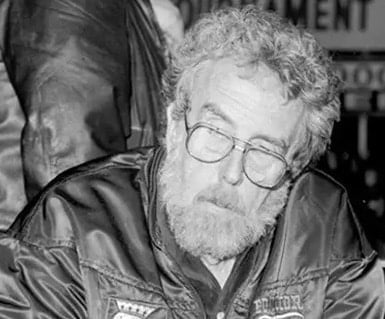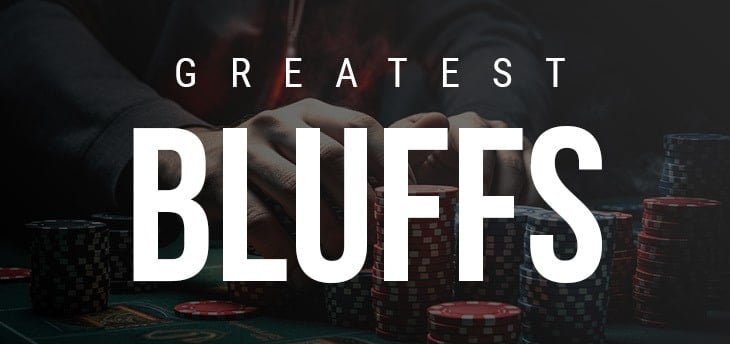Bluffing is, by far and away, the most iconic and exciting part of poker. Great bluffs appear in every depiction of the game, from TV shows like Poker After Dark to Hollywood movies like Casino Royale and Rounders. There’s no better feeling than a well-executed bluff, and the technique has been in the game since its inception.
Bluffing’s older than poker itself, having been present in its ancestors like the 16th-century Persian game As Nas. Since it’s been around for so long, some bluffs have inevitably stood out from the rest. In this article, we’ll cover some of the most iconic bluffs ever.

Isaac Haxton Wins With 2-3
This first hand came from Isaac Haxton’s run at the 2007 PokerStars Caribbean Adventure. At the time, Haxton was one of the foremost online poker pros, sporting a unique playstyle of hyper-aggression. In the hand, he showed his ability to play just about anything. He was heads-up against Ryan Daut’s 7-5 while holding 2-3.
The flop came Q-4-A, bringing essentially no help to either one and leaving them with just an ace-high from the board. Haxton did have a small chance for a wheel draw, so he calls a bet from Daut. The turn brought a king which didn’t help either player.
Both players check on the turn, and the final card is a queen. Haxton senses weakness, placing a bet for $700,000. Daut re-raises to $2 million, trying to stand his ground. Haxton goes into the tank despite his absolutely atrocious hand and finds the courage to go all-in for a massive $7 million. Seeing the strength of the play, Daut folds, giving Haxton a massive pot with 2-3.

Tom “durrrr” Dwan’s Bluff Against Two Pros
Tom “Durrrr” Dwan is another one of the top online poker pros. This hand came from season five of the iconic poker TV show High Stakes Poker. This one’s doubly impressive as it was a three-way pot against pros Barry Greenstein and Peter Eastgate.
The focus of the hand was Greenstein. Known for being a tight player, it’s a near guarantee he has a premium hand if you see him play aggressively pre-flop. This time was no exception, as he raised $2,500 from an early position with AA. Dwan held Q-10, and Eastgate had 4-2. Every player called, leading to a seven-player pot on the flop.
In an insane stroke of luck, Eastgate’s hand skyrockets to the top after the flop comes 2-10-2, giving him trips. Eastgate decides to slow play, checking as not to raise suspicion. Greenstein bets for $10,000, and Dwan goes for a big bluff by raising to $37,300. All four other players fold, so only Eastgate, Dwan, and Greenstein remain.
In a stroke of genius, Dwan makes a huge bet for $104,200. Representing a massive hand like a full house, he gets Greenstein holding AA and Eastgate with a three-of-a-kind to fold, bluffing two seasoned pros who both have stronger hands.

Phil Ivey versus Paul Jackson
Phil Ivey, known as “The Tiger Woods of Poker,” is one of the world’s top poker pros. Equally successful playing high-stakes cash games and million-dollar tournaments, Ivey’s considered one of the best poker players of the modern era. The defining characteristics of his play are his incredible poker face and ability to read his opponents, both of which were on full display as he won this hand.
This hand was the highlight of the 2005 Monte Carlo Millions tournament. True to its name, the winner would collect a $1,000,000 prize. Ivey found himself heads-up against Paul Jackson, and the ensuing bluff battle became one of the most memorable ones ever.
Ivey starts the hand with a huge 4:1 chip lead. Jackson calls Ivey’s blind with 6-5, and Ivey checks. The flop came 7-J-J, and Ivey begins with an $80,000 bet. Undeterred, Jackson re-raises despite having nothing. At this point, Ivey is certain Jackson’s trying to bluff, thinking he would just call if he wanted to extract value.
Ivey doesn’t back down, raising to $320,000. Jackson raises to $470,000, and the commentators exclaim, “Phil Ivey has got to fold here. We’re looking at a million-chip pot, and both players have nothing!”
After a few moments of deliberation, Ivey goes all in, even with a massive chip lead. Jackson finally gives up, folding and immortalizing the hand in poker history.

Jack “Treetop” Straus’ Mind Games
Jack Straus is an American poker pro most known for his 1982 World Series of Poker (WSOP) Main Event run. On the second day, he thought he was eliminated after a hand went awry. Standing up from his seat, he noticed a single $500 chip under a napkin and was allowed to continue playing.
He clawed his way back up from that single chip, winning the tournament and spawning the poker proverb “A chip and a chair,” meaning you always have a chance to come back in a tournament.
This bluff, however, didn’t happen in the WSOP. It was during a high-stakes cash game Straus was participating in. Straus was dealt 2-7, widely acknowledged as the single worst starting hand in poker. Thanks to a recent winning streak, Straus’ confidence was at a record high, which led to him raising pre-flop with the 2-7.
Only one player called, and the flop came 7-3-3. This wasn’t bad for Straus, so he made a continuation bet. However, his tight opponent made a large raise, making Straus realize he likely had an overpair. Undaunted, Straus called to try and bluff on the turn.
The turn brought a two, so the 7-3-3-2 board was useless for Straus’ 2-7. Straus bets, and his opponent starts thinking for a while. Trying to prevent his call, Straus offers to reveal one of his hole cards for a single chip. Thinking it couldn’t hurt, his opponent pays and sees Straus’ two, thinking he has a full house with pocket twos.
The beauty of the play was that whichever one of Straus’ hole cards the opponent saw, they would still think Straus had a full house with a pocket pair. After all, the only other scenario would be Straus betting that aggressively with 2-7, the worst hand in poker.

Chris Moneymaker’s Bluff of the Century
Finally, we have the highlight of Chris Moneymaker’s legendary 2003 WSOP run. His $2.5 million victory singlehandedly sparked the poker boom, increasing poker’s popularity from 2003 to 2006.
It increased WSOP attendance tenfold, from 839 in 2003 to a record 8,779 in 2006. It also made online poker mainstream, as Moneymaker had qualified to the WSOP off a $39 online satellite tournament.
Moneymaker, an accountant, found himself heads-up against Sammy Farha. Farha was an experienced pro, so despite Moneymaker starting out with almost twice Farha’s stack, the two were relatively even after an hour of play.
Both players flopped a backdoor flush draw on a board of 9S-2D-6S, with Moneymaker holding KS-7H and a backdoor straight, against Farha’s QS-9H. Though Moneymaker started with a better hand, Farha had pulled ahead as the 9-high flop gave him top pair.
The 8S on the turn put both players 1 card from the flush and gave Moneymaker the open-ended straight draw. The potential of his hand led to him raising Farha’s 300,000 bet to 800,000 chips. With top pair and his own flush draw, Farha called. The river was a brick; neither player had any completed draws leaving Farha ahead.
The hand looked over for Moneymaker, but he decided to go for a massive all-in bluff. Farha hesitated because who would have thought that an amateur would risk his tournament life on a big bluff against an experienced pro? Nobody would expect that, ever. Farha folded, putting Moneymaker in the lead with three times Farha’s chips.

